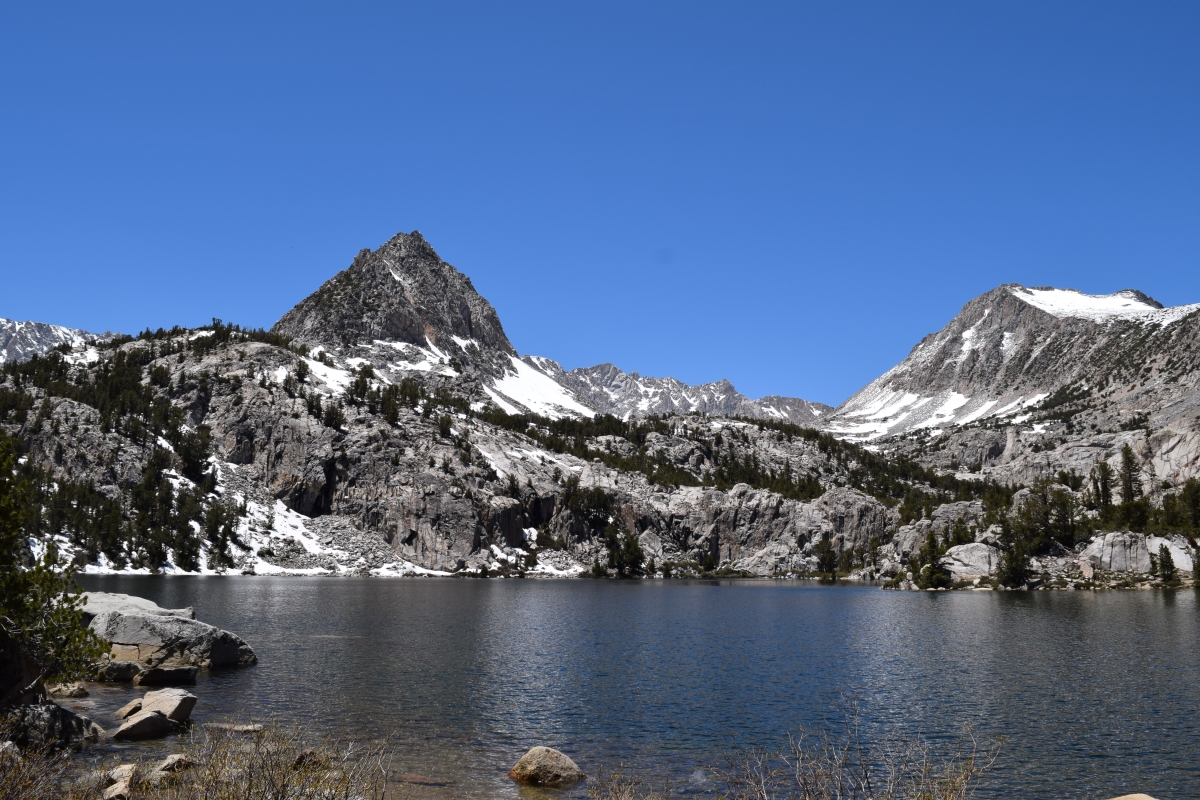I survived my first backpacking trip (barely).
Even with the minor (or major, considering our truck broke down) bumps in the road, there was still beautiful scenery and much to be learned from the Eastern Sierra Nevada Mountains, just outside of Bishop, California.
#1. You’re in Bear Country.
It’s a good thing to remember that when you’re backpacking in the wild, you’re respecting the wild too. This includes protecting yourself and the bears from any harm. Anything that carries a scent (even down to your Burt’s Bees) needs to go in a bear vault, or canister depending on what the brand calls it. I opted for a clear one, so that I could see what was inside the whole time and how much space I had left.
It’s also a good idea wherever you’re headed to check and see if the trail head has a bear box. If it doesn’t, you’ll be hiking into the mountain with anything in your car or truck that has a scent or any food you weren’t planning on taking because you’ll want to prevent bear break ins in your car. This happened to us, and lead to each of us carrying extremely heavy backpacks up through higher and higher altitudes.
#2. If Your Bug Spray has No Chemicals, You’re Doing it Wrong.
Ok, so there’s been a lot of chatter going on in the outdoor world about DEET and whether or not you want to coat your body in it. REI does a great job of distinguishing between DEET and it’s more natural counterparts. They even warn too that you’ll need to reapply frequently if you chose to by pass the chemicals and opt for the natural oils.
It stands to note, as I found from personal experience, you’re wasting your time if you apply insect repellent under your clothes. Apparently it won’t stop those stubborn buggers from biting right through your Columbia layers. Unbeknownst to me, they make clothes that protect you from being bitten right through the surface. To say I was surprised to find this out is a bit of an understatement. Needless to say as I continually itch the bug bites that will not go away, I have learned my lesson on this one.
#3. Camping On a Cliff Looks Cool, But it’s Not All it’s Cracked Up To Be.
So once we got into the mountain, to Lamarck Lake, we searched for a place to camp out for the night. We were torn between two different options- one shaded slightly by some trees and another spot that was on a rock, with a stunning view. Of course, if you’re following where this is going, we picked the latter. Without any protection from the wind we suffered through an entire night of no sleep praying our tent didn’t fly off the cliff side as 35+ MPH winds pounded the tent all night long. Several times I thought I saw my life flash before my eyes as the wind pounded the tent so hard that I though for sure we were not heavy enough to keep it on the ground.
Also, if you don’t often stand outside when the wind blows you may forget that wind can be exceptionally cold especially when you’re at 10,000 feet of altitude and there’s still snow on the mountains. Our rookie mistake here was not selecting a campground that would’ve provided more shelter from the winds. Backpacking is physically exhausting and you’re not eating nearly enough calories to sustain yourself, so if you’re not getting enough sleep every night then you’re going to hinder yourself.
By the way if you’re curious, I wrote a raving 5 star review of the tent we stayed in because that tiny two person tent kept me from plummeting off the mountain side. It’s pricey at $400 and a little heavy at 3.8 pounds. However, it’s one of the best purchases you can make especially for two backpacking. Here’s the tent.

#4. You Should Always Carry a Physical Map.
Maybe this sounds to some people as something that really shouldn’t even be mentioned because of course you should always carry a physical map, but this was our biggest mistake. We had originally planned an entirely different course to hike and ended up at a different lake. This, of course, was because we mistakenly started out at the wrong trail head.
For those looking to hike into the lakes south of Lake Sabrina, don’t be suckered into parking at the sign that says “Camping for North Lake Hikers”, right off the 168. You’re not where you want to be. You need to keep going. This wrong turn led us to hike the wrong trail. We ended up wasting phone battery staring at our maps to get to any lake that we may have been near. Eventually, our phones died.
#5. Don’t Drive an Old Truck.
Because you’ll end up like us, with no service, an empty parking lot of anyone who can help, dead phones, and a truck that won’t start. This will lead you to walk 2 hours to the nearest cafe that has one single landline phone, to call one of three tow truck companies in the Bishop area (since population is under 4,000 people). In turn, you’ll pay $350 for a tow off the mountain, thinking you’ll be stranded with no way to get home….only to have the truck start at a lower altitude.
But I digress.
Backpacking was one interesting adventure that I won’t mind doing again at some point. Hopefully each time I gain just a little more common sense to make each trip a little smoother.
Happy adventuring!

